Back to the Roots
The history of Emil Berliner Studio
Compiled by Rainer Maillard, 2023

Our team totay
Rainer Maillard, Hans Kaiser, Stephan Flock, Sidney, Claire Meyer, Lukas Kowalski, Angela Chastenier, Julian Helms, Justus Beyer, Philip Krause und Matthias Kock. © Dirk Schelpmeier

His Masters Voice
Our oldest member of staff at work. © EBS

2020 Binaural Recording
Binaural recordings using an artificial head are not a new invention, however, they always cause astonishment. Bomsori Kim during a recording at the Meistersaal. © R. Maillard

2018 Emil Berliner Studios goes immersive
Extension of two control rooms from the existing 5.1 to the new 9.1.4. system. Here: Listening session and discussion about sound philosophy in 3D audio. © Philip Krause

2018 »Carmen«
Tape box of a "Carmen" recording from 1977. This analog 16-track recording is being remastered and re-released on SACD in Japan. Two years later, a 5.1 surround sound and Dolby Atmos mix follow. © EBS

2018 Forbidden City
Stephan Flock at the console during a live performance from the Forbidden City in Beijing. © EBS

2016 Research
Emil Berliner Studios conducts hearing tests as part of research assignments. Before we delude ourselves – hearing tests in the form of blind tests. © R. Maillard

2016 Sting
Recording session with Sting and a Syrian ensemble at Emil Berliner Studios. © EBS

2014 Direct-to-Disc
Berlin, Philharmonie. For the first time in almost 70 years, Emil Berliner Studios is carrying out a mobile direct-to-disc recording. Maarten de Boer assists Sir Simon Rattle in signing the lacquer master. Notice in the LP box. »This recording is not available in any other format«. © EBS

2013 Teatro La Fenice
Mobile recording in Venice with equipment transport by gondola. © R. Maillard

2010 New start in Berlin
A new studio building is being constructed at Köthener Straße 38. The Emil Berliner Studios move from Hanover-Langenhagen to Berlin. The opening takes place on 22.10.2010. © EBS

2008 Beethoven
Vienna, Musikverein: mobile recording with Vladimir Repin, Vienna Philharmonic and Riccardo Muti. © EBS
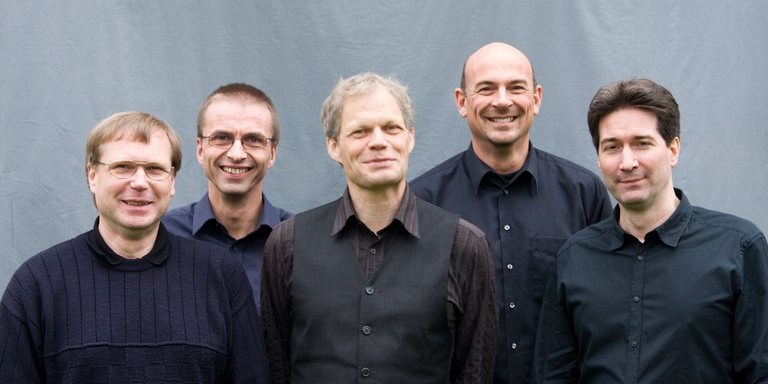
2008 Management Buy-Out
On 1 May 2008, a management buy-out leads to the founding of "EBS Productions GmbH & Co. KG", which carries on the name "Emil Berliner Studios".[1] Rainer Höpfner, Hans-Ulrich Bastin, Rainer Maillard, Evert Menting and Stephan Flock (from left to right: ). © Daniel Schleef

2007 »Symphony of a Thousand«
Berlin, Jesus-Christus-Kirche: Hans-Ulrich Bastin, Ulrich Vette, Pierre Boulez, Matthias Spindler and Christian Gansch in the control room during the recording of Mahler's Eighth Symphony.. © Marcus Blome

2006 Duets
Dresden, Lukaskirche: Rolando Villazón and Anna Netrebko during a recording.. © EBS

2006 Simón Bolívar Symphony Orchestra
Live recording with Gustavo Dudamel and the Simón Bolívar Symphony Orchestra of Venezuela in Caracas. © EBS
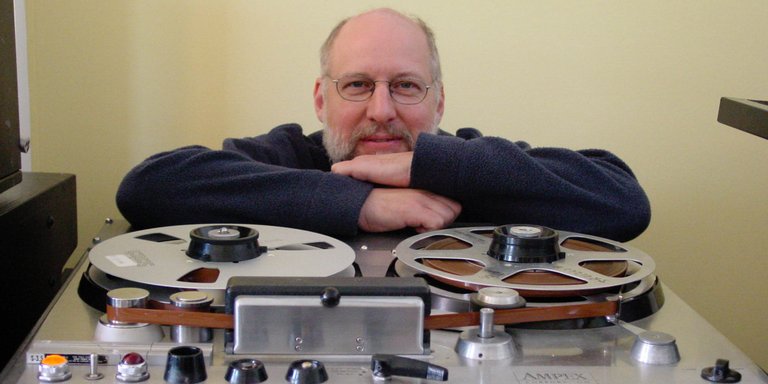
2005 Remastering
Der Tonmeister und Experte für historische Tonbänder Andrew Wedman hinter einer sehr seltenen analogen 3-Spur-Ampex-Maschine. © EBS

2002 Microphone development
Variable polar pattern: in cooperation with Mr. Hibbing (Sennheiser), prototypes are created that render separate signals from two capsules: omni/figure of eight (left) and double diaphragm cardioid (right). The prototype on the right later went into series production as the MKH 800 TWIN.© R. Maillard
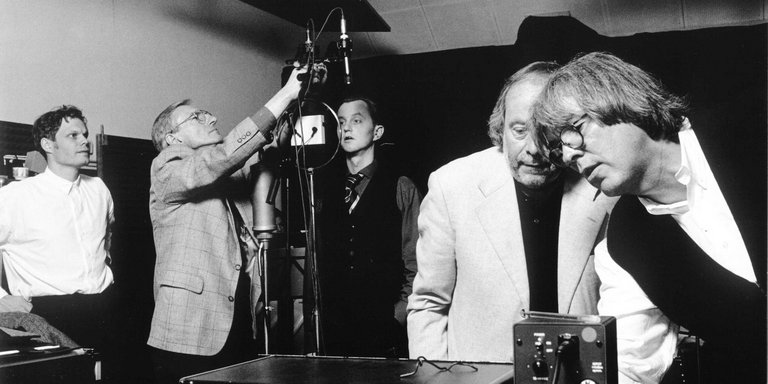
1999 Historic Recording
Berlin: production using a Reisz microphone from 1925. From left to right: Rainer Maillard, Manfred Hibbing (Sennheiser), Max Raabe, Klaus Hiemann and Wolf-Dieter Karwatky. © Hans-Peter Zimmer

1998 High Resolution
The first multi-track recordings in 96 kHz and 24 bit are a real battle of material, recorded on linked and modified Sony DASH machines. © EBS

1996 Digital Mixing
Klaus Hiemann mixing at the Emil Berliner Haus. The recording department modifies their digital Sony 3324 multitrack recorders from 16 to 24 bit. The Nagra-D format is used for recording the masters. © Fotozentrum Zimmermann

1995 Das Emil Berliner Haus
The recording department moves to the "Emil Berliner Haus". It has 10 control rooms (audio and video) for the "Deutsche Grammophon Recording Centre" and 8 control rooms for PolyGram's "Mastering Centre". The new building also houses the tape archive, the audio engineering department and the storage for the six mobile recording units. Oliver Berliner, grandson of Emil Berliner, attends the official opening on 19 June 1996. The street in front of the PolyGram factory in Hanover-Langenhagen (formerly Klusriede) is also renamed Emil-Berliner-Straße. © Fotozentrum Zimmermann

1994 Deutsche Grammophon Recording Centre
At the topping-out ceremony on 10 May 1994, Alain Levy, President and CEO of PolyGram N.V., unveils a commemorative plaque. The Emil Berliner Haus was designed by the Frankfurt architect Kahl Hassdenteufel in close cooperation with Klaus Hiemann. © R. Maillard

1994 4D Audio Recording
Moscow Conservatory: View of the mobile control room. The microphone signals are digitised on stage with remote-controlled microphone preamplifiers, recorded on 4-track Nagra-D tape machines with 24-bit resolution. Recording with the Russian National Orchestra under Mikhail Pletnev with Sergei Prokofiev's ballet music »Cindarella. © EBS

1991 Digital mixing consoles
London: Stefan Shibata (Head of Audio Engineering) during a recording with the possibility of comparing analog (PolyGram Modul Mixer) and digital DMC 1000 mixing consoles, which were developed in collaboration with Yamaha. In the foreground are two Sony 3324 DASH machines; for safety's sake, recording is done in parallel on two systems. © EBS

1991 »Figure of Eight«
Recording with Giuseppe Sinopoli and the Philharmonia Orchestra in London. A special practice of sound engineer Klaus Hiemann is the use of Sennheiser MKH30 (figure-of-eights) as spot microphones. They are characterised by an extremely linear frequency response even with lateral and rear sound input. © EBS

1989 New Year's Concert
Carlos Kleiber and the Vienna Philharmonic during rehearsals for the New Year's Concert. © DGG/EBS

1984 »West Side Story«
New York: Leonard Bernstein records »West Side Story«. Two Sennheiser PZM microphones glued on Plexiglas are used as main microphones. All the recording equipment is delivered to New York City from Hanover. Recorded on digital 3M machines with 24 tracks in 50kHz. The stereo release follows in 1985, an SACD remix in stereo and Surround 5.1 in 2002, and an immersive 3D mix for Dolby Atmos in 2021.© DGG

1882 Compact Disc
Hanover-Langenhagen: Dr. Hermann R. Franz and Claudio Arrau present the Compact Disc to the press. © EBS
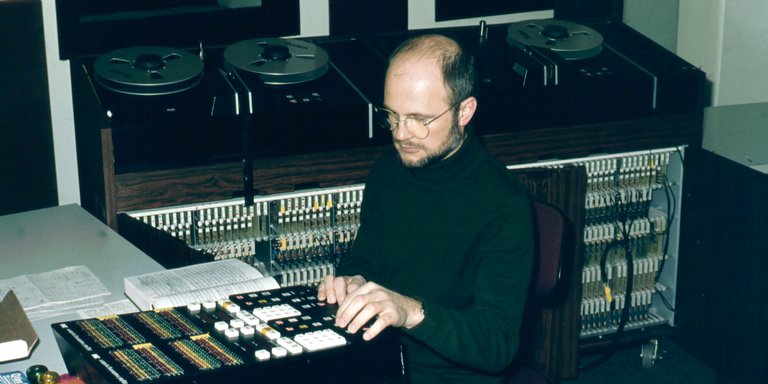
1981 24-track Digital Editing
Jobst Eberhardt editing the "Alpensinfonie", the first official CD release of DGG. It was digitally recorded in 1980 on 24 tracks. Unlike analogue tapes, cutting with scissors and glue is impossible. The so-called digital editing is done by "copy and paste" with the help of two tape machines. Digital audio workstations - as they are used today - are still unknown.. © EBS

1981 Bernstein on Vinyl
Leonard Bernstein with Dr. Hermann Franz, Klaus P. Burkowitz and Godefried Schulze in the cutting studio next to a Neumann VMS 80. The new digital recordings are still only being released on vinyl. © EBS
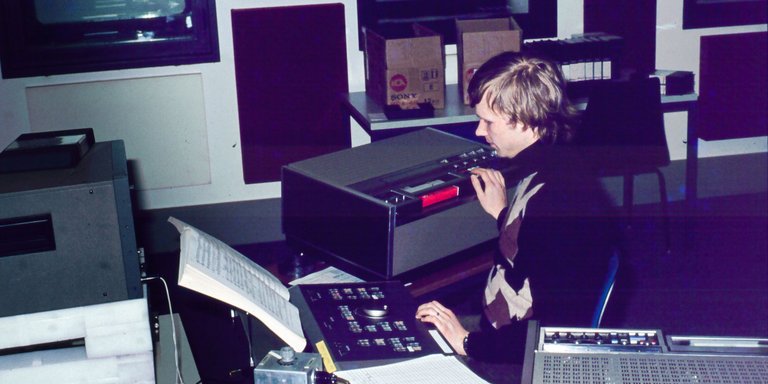
1980 Digital Editing Suite,
Rainer Höpfner using the prototype of a digital Sony editing suite, which is being developed together with the recording department. © EBS

1979 DG goes Digital
Starting in January, the recordings are produced in analog as well as the new digital technology. Since no digital editing suite is operational at that point, the productions are still edited and published in analog format.

1979 Vinyl Mastering
Hella Schröder at the VMS 70. © EBS

1979 »Fidelio«
Vienna, Musikverein: Leonard Bernstein, recording producer Hans Weber and recording engineer Klaus Scheibe in the control room listening to a »Fidelio« production on 8-track tapes. © EBS

16-track
Editing score with 16-track tape snippets. In case an edit has to be changed again later, these snippets are pasted into the score. © Rainer Maillard

1977 Special Projects
In the Special Projects department, Klaus Hiemann and Jost Haase develop devices and applications for aspects such as reverberation measurement and artificial head recordings. Several of them are patented. © EBS

1975 Diamonds
Shortly before the introduction of digital technology, the company is working on the introduction of diamond styli for lacquer mastering instead of sapphire to further improve the quality of analog records.
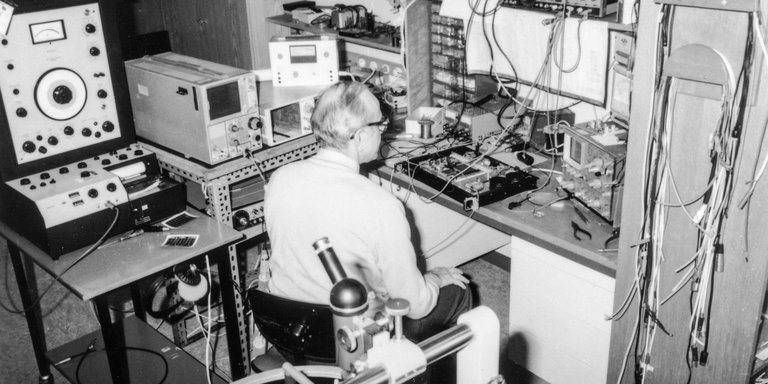
1976 Development
Günther Struck is significantly involved in the development and quality control of cutting technology at Deutsche Grammophon. Among other things, he develops an auto-echo system to reduce pre- and post-techs on the record. © EBS
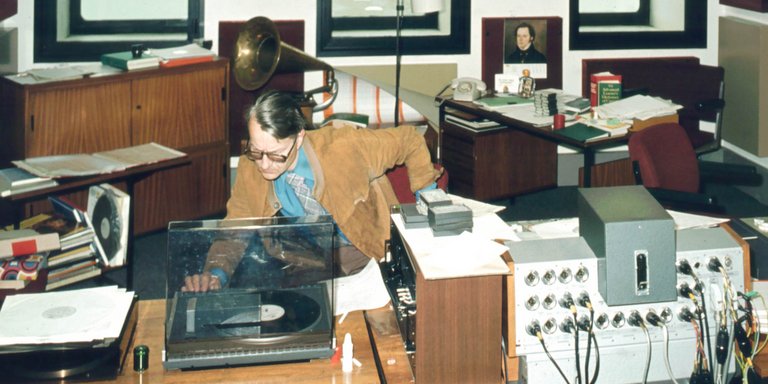
1975 Quality check
Each recording has to undergo a musical and technical quality check before it can be released. In this picture, Otto Ernst Wohlert is checking a test pressing. © EBS

1975 Lab
Physicist Oswald Stephani in Deutsche Grammophone's acoustic laboratory. © EBS

[Translate to Englisch:]
1975 Quadrophony
Klaus Behrens in the new recording center editing 4-track tapes. Since 1971, the DG has been producing its quadraphonic recordings on 1/2-inch tapes. © EBS

1974 »PolyGram Modul Mixer«
Munich: Hans-Peter Schweigmann, Werner Mayer and Edith Mathis on the new PolyGram module mixer during a recording. This transistor console is designed for mobile use and is used worldwide within the PolyGram group. DG is gradually upgrading all its equipment and control rooms with this console. © EBS

1973 »La Damnation de Faust«
Seiji Ozawa records »La Damnation de Faust« by Hector Berlioz with the Boston Symphony Orchestra. The recording is made in DG's own studio in Symphony Hall on 8-track analogue tape. © DGG

1973 »De Temporum Fine Comoedia«
Carl Orff, Herbert von Karajan, Günter Hermanns, Hans Weber, Jürgen Bulgrin and Volker Martin in Leverkusen, Forum © privat

1972 »Messa da Requiem«
In the control room of the Jesus Christ Church in Berlin from left to right: sound engineer Günter Hermannns, sound engineer Volker Martin, Carlo Cossutta, Herbert von Karajan, Christa Ludwig, Mirella Freni, Carlo Cossutta, recording manager Hans Weber and executive producer Hans Hirsch. Production was also for quadraphonic, a rear loudspeaker for quadraphonic playback can be seen at the top left of the picture. © Lauterwasser

[Translate to Englisch:]
1971 »Simon Boccanegra«
Aufnahme von Verdis »Simon Boccanegra« an der Mailänder Scala mit Piero Cappuccilli, Mirella Freni, José Carreras, Ghiaurov, José van Dam, Giovanni Foiani und dem Coro e Orchestra del Teatro alla Scala unter der Leitung von Claudio Abbado. © EBS

1971 Boston Symphony Orchestra on Tour
Michael Tilson Thomas, Christoph Eschenbach and Managing Director Dr. Hans-Werner Steinhausen in the cutting room, which is still located on the old factory in Podbielskistraße. The galvanic and vinyl pressings also remain at the old site until its closure (1990/91). © EBS

1971 »Ma Vlast«
Orchestra set-up for the recording of Smetana's »Ma Vlast« with Rafael Kubelik and the Boston Symphony Orchestra. For acoustic reasons, the chairs are removed and the orchestra is placed in the parquet of Symphony Hall. © DGG

1971 Control room Boston
Peter K. Burkowitz (3rd from left) presents the new DG control room to the international press.. © EBS

1969 Move
The recording department of Deutsche Grammophon moves from Podbielskistraße to the high-rise building on the factory premises II (Hanover-Langenhagen) and occupies the top three floors there. © EBS

1969 »Götterdämmerung«
In the control room of the Jesus Christ Church in Berlin with Helga Dernesch, Herbert von Karajan, Hans Weber and Otto Gerdes. One of the last 2-track recordings with the maestro. After that he only produced in multitrack. © Sammlung H. Weber

1967 Ernst von Siemens
Ernst von Siemens has decisively steered the fortunes of Deutsche Grammophon since the 1940s, most recently in the position of Chairman of the Supervisory Board. He loves to come to Munich for recordings. Here in conversation with Siegfried Janzen in the control room of the Herkulessaal. Behind the mixing desk from left to right: Volker Martin, Günter Hermanns, Carl Orff and Hans Weber, probably during the recording of Carl Orff's »Oedipus Der Tyrann«. © Sammlung H. Weber

1965 »Christmas Oratorio«
Recording in Munich with Karl Richter with sound technician Wolfgang Werner (left) and recording producer Hans Weber (right). © Deutsches Technikmuseum Berlin

1964 »Rigoletto«
Recording of "Rigoletto" under Rafael Kubelik at La Scala in Milan. To improve the acoustics, the auditorium is lined with foils. The recording is made directly on 2-track tape, a subsequent correction of the balance of the voices is excluded. A scaffolding keeps the soloists at a constant distance from the microphone, thus preventing them from regulating their own volume by suddenly stepping forward. © EBS

1962 RIAA
In April 1962, Deutsche Grammophon cutting studios changed the time-constants 3180μs - 318μs - 75μs to 3180 - 318μs - 50μs, thus adapting to the international RIAA standard for vinyl records.

1960 »Elektra«
Dresden, control room at Lukaskirche: During the recording of Strauss's »Elektra«. From left to right: Wolfgang Lohse, Heinrich Keilholz, Jean Madeira, Karl Böhm, Hans-Peter Schweigmann, Inge Borgk and Magdalene Padberg.. © Sammlung Schweigmann

1960 Podbielskistraße
After a brief intermezzo in Hamburg, where parts of the recording department moved with the management of Deutsche Grammophon in 1956, the studios are once again located on the factory premises in Hanover. Here the main building on Podbielskistraße, built in 1927 under the general director Bruno Borchardt. © DGG

1959 »Analogue Tube Console«
Berlin, Jesus-Christus-Kirche: A permanent recording studio with a 12-channel tube mixer is installed, with panpots for no fewer than 6 channels. This console is still being used at our studio.© EBS

1956 Stereo
Günter Hermanns assists head sound engineer Werner Wolf at the first stereo mixing console in the recording department. Five channels are each routed directly to the left and right sum, there is not yet a panpot in the channel strip. The first releases on vinyl follow in August 1958 with »Also sprach Zarathustra« by Richard Strauss and »Feuervogel« by Igor Stravinsky. © Sammlung H. Weber

1954 One Point Recording
Due to the excellent acoustics of the Jesus Christ Church in Berlin, only a single Neumann microphone with an M48 omnidirectional capsule is used for this mono recording. Still free of any stereophonic effect, the orchestra can be set up almost circularly around the microphone. © Sammlung Schweigmann

1952 Beethovensaal
Recording with Heinz Wildhagen, Karlheinz Westphal and Werner Grimme. The mixing console has four channels. Neumann U-47 microphones are mainly being used. © privat

1952 »Erholung«
Recording of "Vis à vis, mon ami" with Michael Jary and Renée Franke. In Hamburg, Deutsche Grammophon maintains two permanently installed studios, one in the Musikhalle, a second diagonally opposite in the "Erholung". This is mainly used for "pop recordings" and is equipped with a Hammond organ.© EBS

1951 Archiv
The "Musikhistorisches Studio der Deutschen Grammophon Gesellschaft" releases recordings in the field of serious music under the brand "Archiv Produktion", where the focus is more on the work and less on the performer. Dr. Fred Hamel, initially takes responsibility for the entire recording production, but later concentrates more and more on the Archiv Produktion. In 1952, Professor Elsa Schiller, until then head of music at RIAS, was appointed to head classical music production. 78 shellac is still the format, the sound engineer and head of the recording department Keilholz is mentioned on the label.
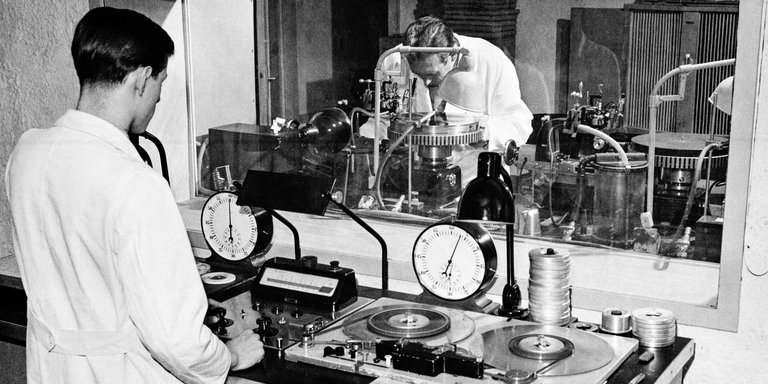
1950 Leap in Quality
Helmut Najda and Georg Söffker during the transfer of a tape recording. New feed-back cutterheads can cut the groove on lacquer instead of wax. The frequency response is extended to 15,000 Hz, a huge increase in quality. The "variable groove control" patented in 1949 by Dr. Gerd Schöttler (DG) and Alexander Schaaf (Siemens) is also used. This can be seen in the retrofitted "pre-listening head" of the tape machine. This allows the playing time to be increased from 5 to 9 minutes and new repertoire to be opened up. This procedure for increasing the playing time is later also used on the vinyl record. © DGG

1949 »Candy-Bomber«
During the Berlin Blockade, Candy Bombers fly over the studio every 3 to 4 minutes. The low-frequency engine noise can often be heard on tape and is visible in the spectral analysis.

1945 Tape Recording
The new recording department in Hanover consistently the new medium of magnetic tape. Musical editing of the tapes using scissors and glue is now possible for the first time. Heinrich Keilholtz, who had previously come into contact with magnetic sound technology at the Reichsrundfunk in Berlin, becomes head of the recording department. Ernst Kwoll, who had previously worked under Eduard Schüller at AEG, is hired as plant engineer. © EBS

1945 New Repertoire
In October, recordings are made for the first time at the Capitol in Hanover using a magnetic tape recorder (instead of wax as before).The head of the factory, Helmut Haertel, sets everything in motion to get hold of this new technology and to be the first record company in the world to use it. During the "Third Reich", this technology was only available to the military and the Reichsrundfunk.The repertoire also adapts to the new era. © EBS

1945 A new start in Hanover
The politically unclear situation in Berlin prompts Deutsche Grammophon to quickly set up a second sound department on the site of the heavily destroyed factory in Hanover. The company hopes to make a new start with a new repertoire. © DGG

1945 A new start in Hanover
Presses are installed in the bombed-out Deutsche Grammophon administration building to supply Berlin and the Soviet sector with records. The records cannot be delivered from Hanover because the trade routes are interrupted. A provisional recording studio is set up, but recording operations do not start realy. The location is completely abandoned in 1949, the management of Deutsche Grammophon and some employees move to Hanover.. © DGG

1945 Destruction
The studio at Alte Jakobstraße is destroyed in an air raid. Some recording equipment can be salvaged from the rubble, but is confiscated by the Russian occupation forces shortly after.. © akg images

1943 Propaganda
Recording log of Charlie and his Orchestra. This big band is put together for propaganda purposes during the Nazi era, producing jazz and other »ostracized music« for German radio broadcasts abroad. © EBS

1941 Dance Music
Sound engineer Oskar Blaesche preparing for a recording with the Arne Hülphers Jazz Orchestra from Sweden on 30.9.1941. Two wax cutting machines from Neumann can be seen in the front, as well as the round boxes with recording waxes. You can see directly into the recording room through the windows.. © DGG

1940 »Symphony in C«
Hans Pfitzner records his own work on 21.11.1940: »Symphony in C« Opus 46. Sound engineer Carl Friedrich Ehrich, Hans Pfitzner and recording supervisor Hans Hasse in the Alte Jakobstraße studio. © Sammlung Frank Schröder

1939 Quartet
Recording with the Heyn-Quartett and the music corps of the Infantry Training Battalion Benedikt Tumforde on 21.4.1939. Sound engineer Ehrich sits in the control room behind the windows. © akg images

1939 »Meistersinger von Nürnberg«
The former Central Theatre in Alte Jakobstraße is being converted into a new Deutsche Grammophon studio. Herbert von Karajan conducts Wagner's Vorspiel to Act 1. Note that it is not the maestro but the microphone that is in the middle. © akg images

1938 Demolition
Recording log of one of the last recordings from the gramophone studio at Lützowstrasse 111/112. The studio is demolished in the course of Albert Speer's plans for the monumental redesign of Berlin.

1934 »Die Perlenfischer«
Recording log of an aria recording with Erna Berger and the State Opera Orchestra conducted by Leo Blech. The room VIII noted on the protocol refers to the large hall at Lützowstraße 111/112, the in-house Deutsche Grammophon studio. Room VII in the same building is used for smaller ensembles.

1933 Escape
31 March 1933 marks the end of the "Bruno Borchardt era". The general manager Borchardt and his colleague Fritz Schönheimer flee to France, Schönheimer takes over the management of the Société Phonographique Française Polydor from Erna Elchlepp. Borchardt takes over Polydor Holding in Switzerland. The chemist Dr. Marie Finkelstein from the recording department also emigrates. She had developed the secret recipe of the low-noise recording waxes ("Finkelstein wax"). © DGG

1932 Classical Music Studio
Despite the economic crisis, General Director Bruno Borchardt sets the course for the acquisition of a large studio with concert hall acoustics at Lützowstraße 111/112. Here classical music recordings can be made "in-house". Borchardt is following a trend here, as direct competitors such as The Grammophone Company (with the Abbey Road Studio) or Elektrola in Berlin are also acquiring large studios especially for recording classical music. Richard Strauss comes to the studio several times for recordings, here in front of a General Electric microphone from the USA. © DGG

1930 »Boléro«
Paris, Polydor Studio: Producer Erna Elchlepp and Maurice Ravel during the recording session of the »Boléro«. The recording equipment had been brought in from Berlin. © privat

1929 Listening Session
Singer Alfred Piccaver (seated) listening to his recording in the Markgrafenstraße studio. To the right of the gramophone stands sound engineer Carl König. © EBS

1929 Mud
Recording expedition in Persia, 8 January: " ... and for the fourth time we pulled the vehicle out of the ditch. On the far right Mr. Blaesche at work". © DGG

1928 Workshop
Walter Schindler, workshop manager at the Berlin recording department, builds electrical cutterhead systems for Deutsche Grammophon's recording devices based on Buhre's plans. © privat

1926 » Von Ohr zu Ohr – Potpourri«
Walter Buhre develops the electric recording process for Deutsche Grammophon. In 1929 he goes to Japan to work as a recording engineer and head of the Polydor Nippon factory until 1953. © John Gaudenz/Deutsches Historisches Museum

1926 Bruno Borchardt
In October 1926, Bruno Borchardt secured for his company the exclusive European distribution of the most attractive American jazz repertoire of the time through an agreement with the Brunswick-Balke-Collander Company based in Chicago. A second contract regulates a transfer of know-how. When he returned from the States, he had a new recording device in his luggage that had been developed by General Electric for Brunswick; in the Polyphon-Grammophon company's own workshop, it was rebuilt and further developed to suit their own purposes. © Phonographische Zeitschrift

1922 Eletric Recording Process
Between 1922 and 1925, Walter Buhre developes the electric recording process for the Polyphon/Grammophon. However, he switched to the American system of General Electric as early as 1926. In 1929 Buhre went to Japan and worked there until 1953 as sound engineer and manager of the Polydor Nippon factory. © EBS
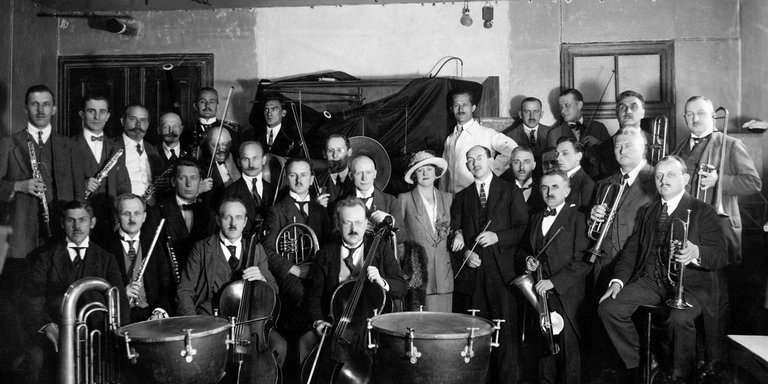
1921 Diva
Berlin, Markgrafenstraße: Opera diva Frieda Hempel, conductor Bruno Seidler-Winkler, sound engineer Paul Goile (white coat) and orchestra at Deutsche Grammophon's new recording studio, in use from 1918 until 1932. © Deutsches Technikmuseum Berlin

1920 Recording Horn
The Berlin recording department has to be reorganized due to the separation from the London Gramophone Company. Recording engineers are hired - here Paul Goile with Wilhelm Kempff in the studio.© DGG

1917 Foreced Sale
24 April 1917 marks the end of an era and the beginning of a whole new development. The assets of the Gramophone Company Ltd., which owns the shares of Deutsche Grammophon AG, are seized in the German Reich and acquired by Polyphon-Musikwerke AG in a forced auction. Bruno Borchardt, General Director and main shareholder, also takes over Deutsche Grammophon as General Director and incorporates it into his group. The new headquarters of the Polyphon-Grammophon Group are created at 76 Markgrafenstraße in Berlin and new recording studios are also set up. © DGG

1915 World War I
World War I turns colleagues into enemies: Vice Sergeant Max Hampe (middle) on the Western Front. Gramophone Company and Deutsche Grammophon are torn apart.

1913 »Parsifal«
Berlin, Ritterstraße, Sep 12: Alfred Hertz, conductor of New York's Metropolitan Opera, records excerpts from Wagner's »Parsifal« with the Berlin Philharmonic Orchestra. © DGG

1911 More Volume
Berlin, Ritterstraße: With recording engineer Charles Scheuplein from the Gramophone Company working the movable horns, Bruno Seidler-Winkler conducts a recording with tenor Karl Jörn at the Deutsche Grammophon's studio. Prepared instruments are used to achieve more volume in the arrangement. © DGG

1909 Tolstoi
Yasnaja Polyana, Leo Tolstoy's country estate south of Moscow: Max Hampe records the great poet reading, Tolstoy personally signs the wax discs.

1905 Bombay
Recording expedition, Bombay: Max Hampe from Deutsche Grammophon and his colleague William Sinkler Darby from the British Gramophone Company..

1900 First Recording Studio
Deutsche Grammophon opens an office at Ritterstrasse 36 in Berlin and sets up a recording studio there. The recording technology comes from the British parent company The Gramophone Company. Its American sound engineer William Sinkler Darby travels several times from London to Berlin and directs the construction of the studio[2]. In 1910, the company moves to Ritterstrasse 35, and Darby in turn becomes a shareholder[3] in Deutsche Grammophon Spezialhaus GmbH. © EBS

1898 The Maker
Joseph Berliner (2nd from right) founded[4] Deutsche Grammophon Gesellschaft in 1898 to produce records exclusively for the English Gramophone Company. He tries to produce recordings from Hanover in 1899 with the help of William Sinkler Darby, but immediately comes into conflict with the English Gramophone Company. Emil Berliner is forced to travel from the USA to Europe to settle the conflict[5]. The 1900 restructuring of Deutsche Grammophon into a joint-stock company (under English ownership) then clears the way for the company to set up its own recording studio in Berlin. © Deutsches Technikmuseum Berlin © Deutsches Technikmuseum Berlin

1898 The nucleus of the music industry
Washington D.C.: Emil Berliner (seated l.) with his employees, including the later famous producers Fred Gaisberg (standing l.), William Sinkler Darby (standing 4th from l.) and Joseph "Joe" Sanders (2nd from l.). In 1898 Berliner sent Fred Gaisberg to London to set up the recording department of the Gramophone Company and his nephew Joseph Sanders with presses to Hanover to set up the record factory of the Deutsche Grammophon Gesellschaft with his brother Joseph Berliner. Successor companies to these pioneers gathered in this picture have today given rise to Universal-Music, Warner & Sony, among others.
- [1] The former Emil Berliner Studios GmbH, a devision of Deutsche Grammophon, is liquidated.
- [2] Matthias Sarneck, "Aus der Geschichte der Deutschen Grammophon-Gesellschaft," unpublished manuscript, DGG Archives, p. 1.
- [3] No. 238 of the register of notaries for 1909, DGG estate Deutsches Technikmuseum Berlin
- [4] There are different statements about the founding fathers of the Deutsche Grammophon Gesellschaft: 1) Dr. Walter Betcke writes in 1948 on the occasion of the 50th anniversary of the Deutsche Grammophon "Joseph Berliner decided to manufacture speaking machines and records on a large scale and for this purpose founded the Deutsche Grammophon Gesellschaft mbH with its headquarters in Hanover on 6.12.1898" 2) In 1963, Edwin Hein quotes Joseph Berliner in his book, 65 Years of the Deutsche Grammophon Gesellschaft, from a letter written by Joseph Berliner in 1913: "Thereupon, in association with my present partner, my brother, Mr. Jakob Berliner in Hanover, and the inventor of the gramophone, my brother Emile Berliner in Washington, I founded the Deutsche Grammophon Gesellschaft in Hanover, registered in the Commercial Register of the Königl. 3) Peter Martland writes in his 2013 book Recording history : the British record industry, 1888-1931 "In November 1898 Joseph Sanders, together with Emile Berliner's brothers Joseph and Jacob, formed Deutsche Grammophon Gesellschaft" and is the only one to cite a copy of the business registration as a source. It seems to have been proven that Joseph Berliner was the only entrepreneurial force behind the establishment of the Deutsche Grammophon Gesellschaft. His big brother and inventor Emil Berliner, on the other hand, can be regarded as the spiritual father of the company - regardless of whether he was a partner or not - because without his work in the U.S., the Deutsche Grammophon Gesellschaft would probably not have been founded in his hometown of Hanover.
- [5] Cf. Peter Martland The British Record Industry,1888-1931 p. 53